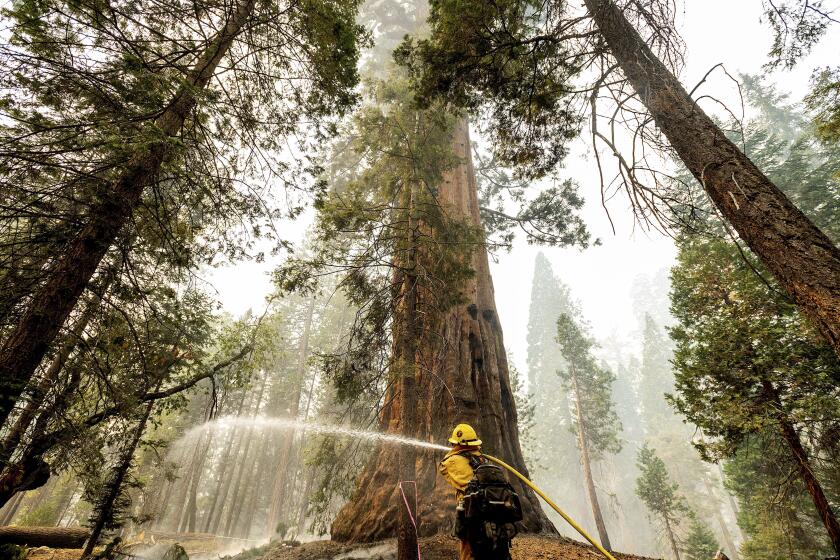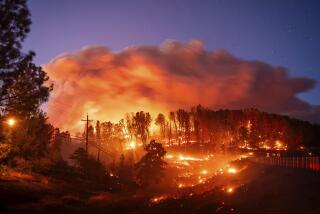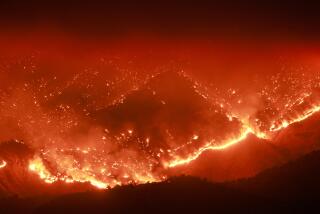Wildfires approach more giant sequoias and worsen air quality across Central California

- Share via
Twin blazes continued to threaten California’s towering sequoia trees and create new miseries for nearby residents, spewing smoke and worsening air quality across Central California on Wednesday.
From Fresno to Tulare, the air was hazy and ash-filled from the Windy and KNP Complex fires. Officials in the San Joaquin Valley and the Bay Area issued air quality alerts warning residents to take precautions.
The two fires have burned through nearly 60,000 acres combined, officials said, with hardly any containment.
Days-long efforts to defend Sequoia National Park’s most famous trees from the 28,241-acre KNP Complex have proven mostly successful so far, with crews crediting proactive firefighting and a history of prescribed burns for preventing significant damage to the Giant Forest, including the General Sherman tree and the Four Guardsmen trees.
But the fire on Wednesday was creeping northwest toward the smaller Lost Grove and Muir Grove, which together are home to hundreds of giant sequoias, according to KNP incident spokesman Mark Garrett.
“Those don’t have the prescribed fire history like Giant Forest, so we’re working in there to protect a lot of that area in case the fire does reach there,” he said.
Flames from the Windy fire reach the top of the Bench Tree along the Trail of 100 Giants, while the KNP Complex shifts toward 65 historic cabins.
Crews were also watching the southeastern edge of the fire, where flames are threatening dozens of historic cabins in Mineral King, Cabin Cove and Silver City. Firefighters wrapped some of the structures in protective foil and were wetting the area with sprinklers.
A rocky rim known as Paradise Ridge has helped keep the fire away from the cabins, but the century-old homes remained a “real high priority” on Wednesday, KNP Complex operations section chief Jon Wallace said during a morning update.
“We’re going to keep hammering away at that today,” he said. “We would love to be able to tell the folks in that Mineral King area that they are out of harm’s way from this wildfire.”
John Crowe, president of the Mineral King District Assn., said most of the cabins were made of wood and “highly flammable.” Some of the cabins date back to the 1870s, and many have been in the same families for generations.
“It’s a historic location that we’d like to preserve, not only for ourselves, but for posterity, for the public,” he said.
The fire has also spurred additional closure orders in Sequoia and Kings Canyon national parks, with officials adding Cedar Grove and Grant Grove to a list of areas closed to the public.
The KNP Complex on Wednesday remained uncontained.
Farther south, the 31,388-acre Windy fire burning in the Tule River Reservation and Giant Sequoia National Monument has reached 7% containment, officials said.
Similar firefighting efforts kept the flames away from most trees in the Long Meadow Grove, home to the Trail of 100 Giants, although one giant sequoia known as the Bench Tree has been torched.
Attempts to assess damage in other, more remote areas like the Peyrone Grove and Red Hill Grove remain ongoing, with officials noting that the groves were “completely surrounded” by wildfire earlier this week.
Windy fire incident spokesman Steve Rasmussen said flames were mostly holding within the current perimeter, enabling crews to make some gains.
“Obviously, it has the opportunity to make active runs, but I think we’re in as best a chance as we can get right now to really hold this fire,” he said.
The top priority Wednesday will be the southwestern edge of the blaze, where some spot fires have jumped containment lines. Crews are working to keep the spots out of the Tule River Reservation, where they could threaten critical infrastructure, and steer them back into the main body of the fire, he said.
Even as crews get a slight handle on the fires, smoke remains a threat. The National Weather Service said air quality would be affected in at least eight counties Wednesday: San Joaquin, Stanislaus, Merced, Madera, Fresno, Tulare, Kings and the valley portion of Kern County.
Residents in all affected areas are advised to take precautions, as exposure to smoke particles can aggravate lung problems and increase the risk of respiratory infections. People with respiratory ailments are advised to stay indoors.
“Yesterday was really bad,” said Colin McKellar, a meteorologist with the National Weather Service in Hanford, on Wednesday morning. “It smelled like smoke the whole day, and it was very thick at the surface. It was just where you couldn’t see the sun at all.”
McKellar said winds could push the smoke east for a brief period on Wednesday before a flow reversal kicks it back into the Central Valley.
“Smoke here in the valley is kind of hard to scour out because we don’t get a lot of wind,” he added. “It’s still pretty hazy up here.”
The air quality alert will remain in effect through Thursday, when a trough is expected to pass through the region and help disperse some of the smoke.
More to Read
Sign up for Essential California
The most important California stories and recommendations in your inbox every morning.
You may occasionally receive promotional content from the Los Angeles Times.












